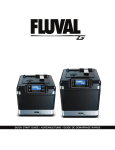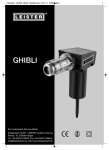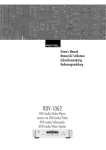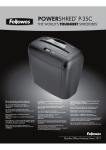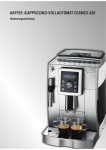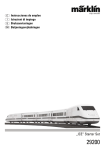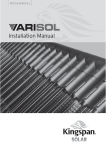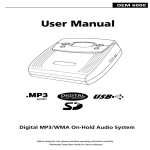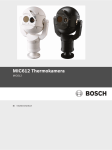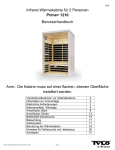Download Bedienungsanleitung Leister Diode PID
Transcript
Titelseite_Titelseite.qxd 21.10.13 13:11 Seite 1 DIODE S DIODE PID Ihre autorisierte Service-Stelle: Klappenbach GmbH - LEISTER-Vertrieb & Service Rohrstr. 16, D-58093 Hagen Tel. +49-(0)2331-95940, Fax +49-(0)2331-959444 [email protected] http://www.klappenbach.de 2 3 4 Diode.book Seite 2 Dienstag, 16. Oktober 2007 2:41 14 -2- Deutsch .................... Bedienungsanleitung........................................ 4 Englisch.................... Operating Instructions...................................... 7 Diode.book Seite 1 Dienstag, 16. Oktober 2007 2:41 14 A DIODE S 7 6 5 1 B 2 3 8 4 DIODE PID 9 7 6 5 8 1.1 3.1 4 Deutsch - 4 - Sicherheitshinweise WARNUNG: Die Nichtbeachtung der Sicherheitshinweise kann beim Arbeiten mit dem Heißluftgerät zu Feuer, Explosion, elektrischem Schlag oder Verbrennungen führen. Lesen Sie die Bedienungsanleitung vor der Benutzung und halten Sie stets die Sicherheitsvorschriften ein. Bewahren Sie die Bedienungsanleitung auf und geben Sie diese einer nicht-eingewiesenen Person vor der Benutzung. WARNUNG: Falsch angeschlossene Netzstecker können zu einem lebensgefährlichen elektrischen Schlag führen. Lassen Sie Netzstecker nur von einem Fachmann an das Kabel anschließen. Ein beschädigtes Gehäuse oder ein geöffnetes Gerät kann zu einem lebensgefährlichen elektrischen Schlag führen. Öffnen Sie das Gerät nicht und nehmen Sie ein beschädigtes Gerät nicht in Betrieb. Bohren Sie das Gehäuse nicht an, um z. B. ein Firmenschild zu befestigen. Ziehen Sie vor allen Arbeiten am Gerät den Netzstecker. Ein beschädigtes Anschlusskabel kann zu einem lebensgefährlichen elektrischen Schlag führen. Kontrollieren Sie das Anschlusskabel regelmässig. Nehmen Sie das Gerät bei beschädigtem Kabel nicht in Betrieb. Ein beschädigtes Kabel immer durch einen Fachmann ersetzen lassen. Wickeln Sie das Kabel nicht um das Gerät und schützen Sie es vor Öl, Hitze und scharfen Kanten. Tragen Sie das Gerät nicht am Kabel und benutzen Sie es nicht, um den Stecker aus der Steckdose zu ziehen. Beim Einsatz des Gerätes auf Baustellen und im Freien ist ein Fehlerstrom-(FI-) Schutzschalter für den Personenschutz zu verwenden. WARNUNG: Arbeiten im Regen oder in feuchter bzw. nasser Umgebung kann zu einem lebensgefährlichen elektrischen Schlag führen. Berücksichtigen Sie die Witterungsverhältnisse. Halten Sie das Gerät trocken. Bei Nichtbenutzung das Gerät trocken aufbewahren. WARNUNG: Explosionsgefahr! Das Heißluftgebläse kann brennbare Flüssigkeiten und Gase explosionsartig entzünden. Arbeiten Sie nicht in einer explosionsgefährdeten Umgebung. Untersuchen Sie vor Arbeitsbeginn das Umfeld. Arbeiten Sie nicht in der Nähe von oder an Kraftstoffen oder Gasbehältern, auch wenn diese leer sind. WARNUNG: Feuergefahr! Hitze kann brennbare Materialien erreichen und entzünden, die sich nicht sichtbar hinter Verschalungen, in Decken, Böden oder Hohlräumen verbergen. Überprüfen Sie vor Arbeitsbeginn den Arbeitsbereich und verzichten Sie bei unklarer Situation auf den Einsatz des Heißluftgerätes. Halten Sie das Gerät nicht längere Zeit auf die gleiche Stelle gerichtet. Betreiben Sie das Gerät immer beaufsichtigt. WARNUNG: Vergiftungsgefahr! Bei der Bearbeitung von Kunststoffen, Lacken oder ähnlichen Materialien entstehen Gase, die aggressiv oder giftig sein können. Vermeiden Sie das Einatmen von Dämpfen, auch wenn diese unbedenklich scheinen. Sorgen Sie stets für eine gute Belüftung des Arbeitsplatzes oder tragen Sie ein Atemschutzmaske. WARNUNG: Verletzungsgefahr! Der Heißluftstrahl kann Personen oder Tiere verletzen. Das Berühren des heißen Heizelementrohres oder der Düse führt zu Hautverbrennungen. Halten Sie Kinder und andere Personen vom Gerät fern. Heizelementrohr und Düse im heißen Zustand nicht berühren. Verwenden Sie das Gerät nicht zum Erhitzen von Flüssigkeiten oder zum Trocknen von Gegenständen und Materialien, die durch die Einwirkung von Heißluft zerstört werden. WARNUNG: Verletzungsgefahr! Ein unbeabsichtigtes Anlaufen oder das unerwartete Einschalten der Heizung nach dem Auslösen des Temperaturbegrenzers kann zu Verletzungen führen. Vergewissern Sie sich, dass der Schalter beim Anschliessen an das Stromnetz ausgeschaltet ist. Schalten sie das Gerät aus, wenn der Temperaturbegrenzer angesprochen hat. Konformität Leister Technologies AG, Galileo-Strasse 10,CH-6056 6056 Kaegiswil / Schweiz bestätigt, dass dieses Produkt in der von Leister Process Technologies, Galileo-Strasse 10, Kaegiswil/Schweiz uns in Verkehr gebrachten Ausführung die Anforderungen der folgenden EU-Richtlinien erfüllt. 2006/42, 2004/108, 2006/95, 2011/65 2004/108, 2006/95 Richtlinien: EN 12100-2, EN EN 14121-1, ENEN 55014-1, EN12100-1, 55014-1,ENEN 55014-2, 50366, 62233,EN EN55014-2, 61000-3-2, EN 61000-3-3, Harmonisierte Normen: EN ENEN 61000-3-3, EN 62233, EN 60335-2-45, EN 50581 EN61000-3-2, 61000-3-3, 60335-2-45 60335-2-45 Kägiswil, 19.07.2012 Kaegiswil, 03.02.2012 Bruno von Wyl, CTO Beat Mettler, COO Entsorgung Elektrowerkzeuge, Zubehör und Verpackungen sollen einer umweltgerechten Wiederverwertung zugeführt werden. Nur für EU-Länder: Werfen Sie Elektrowerkzeuge nicht in den Hausmüll! Gemäß der Europäischen Richtlinie 2002/96 über Elektro- und Elektronik-Altgeräte und ihrer Umsetzung in nationales Recht müssen nicht mehr gebrauchsfähige Elektrowerkzeuge getrennt gesammelt und einer umweltgerechten Wiederverwertung zugeführt werden. Diode.book Seite 5 Dienstag, 16. Oktober 2007 2:41 14 Deutsch - 5 - Technische Daten Spannung Frequenz Leistung Temperatur [V] [Hz] [W] [°C] [°F] min. Luftmenge (20°C) [l/min] [cfm] Gewicht (mit 3 m Kabel [kg] und 3 m Luftschlauch) [lbs] Abmessungen L x Ø [mm] Schutzklasse 42 600 DIODE S und DIODE PID 100 120 50/60 1400 1600 20 – 600 70 – 1110 40 1,4 1,15 2.5 265 x Ø 40 II/ (Doppelt isoliert) 230 1600 Geräteelemente 1. Düse*, gesteckt 1.1. Düse*, geschraubt 2. Schraube 3. Heizelementrohr für gesteckte Düsen* 3.1. Heizelementrohr für geschraubte Düsen* 4. Gekühltes Schutzrohr 5. Handgriff 6. Luftschlauch 7. Netzanschlussleitung 8. Potentiometer für Temperatureinstellung 9. Digitale Anzeige Bestimmungsgemäßer Gebrauch Dieses Heißluftgerät ist unter Einhaltung der Sicherheitsvorschriften und Verwendung von Original-Leister-Zubehör für alle in dieser Bedienungsanleitung aufgeführten Heißluft-Anwendungen bestimmt. Anwendungen Schweißen von thermoplastischen Kunststoffen sowie einzelnen Elastoplasten und Elastomer-Bitumen in Form von Platten, Rohren, Profilen, Dichtungsbahnen, beschichteten Geweben, Folien, Schäumen, Fliesen und Bahnen. Folgende Verfahren sind möglich: Überlapp-, Draht, Band, Heizelement- und Schmelzschweißen mit Leister-Düsen Aufheizen zum Formen, Biegen und Aufmuffen von thermoplastischen Halbzeugen und Kunststoff-Granulaten Trocknen von wässrig-feuchten Oberflächen Schrumpfen von Wärmeschrumpfschläuchen, -Folien, -Bändern, Lötverbindern und Formteilen Löten von Kupferrohren, Lötverbindern und Metallfolien Auftauen von eingefrorenen Wasserleitungen Aktivieren/Lösen von lösungsmittelfreien Klebstoffen und Schmelzklebern Trennen und Verschmelzen von synthetischen Fäden und Geweben Entfernen von Kunststoff-Pressgrat und Glänzen der Kunststoff-Oberflächen Düse montieren Das Berühren der heißen Düse kann zu einer schweren Verbrennung führen. Vor dem Aufsetzen bzw. Wechseln der Düse das Gerät ganz abkühlen lassen oder ein geeignetes Werkzeug benutzen. Eine herunterfallende Düse kann einen Gegenstand entzünden. Die Düsen müssen fest und sicher auf dem Gerät montiert sein. Eine heiße Düse kann eine Unterlage entzünden. Legen Sie die heiße Düse nur auf einer feuerfesten Unterlage ab. Eine falsche oder defekte Düse kann zu Heißluftstau führen und das Gerät beschädigen. Nur für Ihr Gerät geeignete Original-Leister-Düsen verwenden. Bei Geräten mit gesteckter Düse*: Die Düse 1 auf das Heizelementrohr 3 aufschieben und Schraube 2 festziehen. Bei Geräten mit geschraubter Düse*: Die Düse 1.1 auf das Heizelementrohr 3.1 aufschrauben und mit Gabelschlüssel SW 17 festziehen. * Düsen nicht im Lieferumfang enthalten! Diode.book Seite 6 Dienstag, 16. Oktober 2007 2:41 14 Deutsch - 6 - Inbetriebnahme Netzanschlussleitung und Stecker auf mechanische Beschädigung prüfen! Netzspannung beachten:ÊiÊ iÌâë>Õ}ÊÕÃÃÊÌÊ`iÊ}>LiÊ>ÕvÊ`iÊ/Þ«ÃV `Ê`iÃÊiÀBÌiÃÊØLiÀiÃÌ i°Ê6iÀB}iÀÕ}Ã>LiÊØÃÃiÊiiÊ+ÕiÀÃV ÌÌÊÛÊ°ÊÓÊÝÊ£]xÊÓÊ >Li° -V i~iÊ-iÊ`iÊÕvÌÃV >ÕV Ê6Ê>Ê`>ÃÊV `ÀÕV}iLBÃiÊiÃÌiÀÊ ",Ê`iÀÊ,"1-/Ê>°ÊiÊÃÌ>ÕL >Ì}iÀÊÕvÌ ÕÃÃÊiÊÕvÌvÌiÀÊÛiÀÜi`iÌÊÜiÀ`i° ÌiÀ>ÌÛÊ>Ê`>ÃÊiÀBÌÊ>ÊiiÊ iÀV iÊÀÕVÕvÌ>ÃV ÕÃÃÊÌÊ&ÊÕ`Ê7>ÃÃiÀ>LÃV i`iÀÊLiÌÀiLi ÜiÀ`i°ÊiÊÕvÌi}iÊÕÃÃÊØLiÀÊiiÊiÃÌiÀÊÕvÌi}iÀi}iÀÊ>}i«>ÃÃÌÊÜiÀ`i° Das Gerät darf nicht ohne ausreichende Luftversorgung betrieben werden! -V i~iÊ-iÊ`>ÃÊiÀBÌÊ>Ê`iÊ iÌâë>Õ}Ê>° A -ÌiiÊ-iÊ`iÊ/i«iÀ>ÌÕÀÊÌÊ`iÊ*ÌiÌiÌiÀÊ8Ê>V Êi`>ÀvÊi°ÊiÊÕv iââiÌÊLiÌÀB}ÌÊV>°ÊÎÊ° B -ÌiiÊ-iÊ`iÊ/i«iÀ>ÌÕÀÊÌÊ`iÊ*ÌiÌiÌiÀÊ8Ê>V Êi`>ÀvÊi°ÊiÊi}iÃÌiÌiÊÕ`Ê`iÊÌ>ÌÃBV V iÊ/i «iÀ>ÌÕÀÊÜiÀ`iÊÊë>ÞÊ9Ê>}iâi}Ì°ÊiÊÕv iââiÌÊLiÌÀB}ÌÊV>°ÊÎÊ°ÊiÊÌÀiÊ`iÀÊ/i«iÀ>ÌÕÀÊiÀv}Ì }iB~Ê6-,V ÌiÊÓÓän° A B Ài iÊ-iÊâÕÊLØ iÊ`>ÃÊ*ÌiÌiÌiÀÊ8Ê>ÕvÊ*ÃÌÊä°Ê/ÀiiÊ-iÊ`>ÃÊiÀBÌÊÛÊ`iÀÊ iÌâë> Õ}ÊÃL>`ÊiÃÊ>L}iØ ÌÊÃÌ° i}iÊ-iÊ`>ÃÊiÀBÌÊ>ÕvÊiiÀÊviÕiÀviÃÌiÊ1ÌiÀ>}iÊ>LÊ`iÀÊÛiÀÜi`iÊ-iÊiiÊ}ii}iÌiÊiÀBÌi >ÌiÀ° Arbeitshinweise q iÃÌiÀÊ*ÀViÃÃÊ/iV }iÃÊÜiÊ>ÕV Ê`iÊ-iÀÛVi-ÌiiÊLiÌiÊÃÌiÃiÊÕÀÃiÊÊiÀiV Ê`iÀÊÜi`Õ}iÊ>° q /iÃÌÃV Üi~Õ}Ê}iB~Ê-V Üi~>iÌÕ}Ê`iÃÊ>ÌiÀ> iÀÃÌiiÀÃÊÕ`Ê>Ì>iÊ ÀiÊ`iÀÊ,V ÌiÊÛÀ i i°Ê/iÃÌÃV Üi~Õ}Ê«ÀØvi°Ê-V Üi~Ìi«iÀ>ÌÕÀÊ>V Êi`>ÀvÊ>«>ÃÃi° B ÊDigitale Anzeige 9/Fehlermeldungen Temperaturanzeige: Fehlermeldungen: ÃÌ7iÀÌ -7iÀÌ ÕvÃÕ}ÊÓÉÎÊc Ê`iÀÊ£äÊc `iÃÌÕvÌi}iÊÕÌiÀ ÃV ÀÌÌiÊ ➠ÊÕvÌi}iÊÀV Ì}ÊiÃÌi Õ}ÊLâÜ°ÊÕvÌÛiÀÃÀ}Õ}Ê «ÀØvi >Ý°ÊâÕBÃÃ}iÊ/i«iÀ>ÌÕÀÊ ÜÕÀ`iÊØLiÀÃV ÀÌÌi ➠ÊiÀBÌÊ>LØ iÊ>ÃÃiÊ Õ`Ê/i«iÀ>ÌÕÀiÃÌiÕ}Ê ÀÀ}iÀi Allgemeine Maßnahmen bei Fehlermeldungungen und Störungen: >ÃÊ*ÌiÌiÌiÀÊ>ÕvÊ-ÌiÕ}ÊäÊ`Ài iÊ`iÀÊ`>ÃÊiÀBÌÊV>°ÊxÊ-iÕ`iÊÛÊ`iÀÊ iÌâë>Õ}ÊÌÀiiÊ>ÕÌ> ÌÃV iÀÊ,iÃiÌ®° >ÃÊiÀBÌÊ>LØ iÊ>ÃÃi°Ê-V >ÕV ÛiÀL`Õ}]ÊÕvÌ`ÕÀV vÕÃÃ]ÊÕvÌi}iÊÕ`Ê iÌâë>Õ}Ê«ÀØvi°Ê>ÃÊ*Ìi ÌiÌiÀÊÜi`iÀÊ>ÕvÊ`iÊ}iÜØÃV ÌiÊ7iÀÌÊiÃÌiiÊLâÜ°ÊiÀBÌÊÜi`iÀÊ>Ê`iÊ iÌâë>Õ}Ê>ÃV i~i° q i}ÌÊ`iÀÊi iÀÊ>ÃV i~i`ÊiÀÊV ÊÛÀ]ÊiÌëÀiV i`iÊ-iÀÛVi-ÌiiÊÌ>ÌiÀi° Heizelementschutz: q ÃÌÊiÊÕvÌÃÌÀÊÛÀ >`i]ÊÜÀ`Ê`iÊiâÕ}Ê>ÕÌ>ÌÃV Ê>L}iÃV >ÌiÌ° q ÃÌÊ`iÀÊÕvÌÃÌÀÊâÕÊ}iÀ}]ÊÜÀ`Ê`iÊiâiÃÌÕ}ÊÀi`ÕâiÀÌÊÕ`Ê`iÊ/i«iÀ>ÌÕÀÊ>ÕvÊV>°ÊÈääÊc ÊLi}ÀiâÌ° Wartung, Service und Reparatur – Netzanschlussleitung und Stecker auf Unterbruch und mechanische Beschädigung prüfen. – Vor allen Arbeiten am Gerät: Netzstecker ziehen. q iÀBÌÊÕ`ÊØvÌÕ}ÃÃV ÌâiÊÃÌiÌÃÊÃ>ÕLiÀÊ >Ìi]ÊÕÊ}ÕÌÊÕ`ÊÃV iÀÊâÕÊ>ÀLiÌi° q ÃÊ`>ÀvÊÕÀÊ"À}>iÃÌiÀ<ÕLi ÀÊÛiÀÜi`iÌÊÜiÀ`i° -ÌiÊ`>ÃÊiÀBÌÊÌÀÌâÊÃÀ}vBÌ}iÀÊiÀÃÌiÕ}ÃÊÕ`Ê*ÀØvÛiÀv> ÀiÊi>Ê>ÕÃv>i]ÊÃÌÊ`iÊ,i«>À>ÌÕÀÊÛÊiiÀÊ>ÕÌ ÀÃiÀÌiÊiÃÌiÀ-iÀÛVi-ÌiiÊ>ÕÃvØ ÀiÊâÕÊ>ÃÃi° Gewährleistung Für dieses dieses Gerät Gerät besteht besteht grundsätzlich grundsätzlich Gewährleistung Gewährleistung gemäss gemäss den den gesetzlichen gesetzlichen//länderspezifischen länderspezifischen>V ÜiÃÊ`ÕÀV Für Bestimmungen Bestimmungen ØÀÊ`iÃiÃÊiÀBÌÊLiÃÌi ÌÊiiÊ}ÀÕ`ÃBÌâV iÊiÜB ÀiÃÌÕ}ÊÛÊiiÊ£®Ê> ÀÊ>LÊ>Õv`>ÌÕÊ ab Kaufdatum Kaufdatum (Nachweis (Nachweis durch durch Rechnung Rechnung oder oder Lieferschein). Lieferschein). Entstandene Entstandene Schäden Schäden werden werden durch ab ,iV Õ}Ê`iÀÊiviÀÃV i®°ÊÌÃÌ>`iiÊ-V B`iÊÜiÀ`iÊ`ÕÀV ÊÀÃ>ÌâiviÀÕ}Ê`iÀÊ,i«>À>ÌÕÀÊLiÃiÌ}Ì°Êiâ durch Ersatzlieferung Ersatzlieferung oder Reparatur Reparatur beseitigt. beseitigt. Heizelemente Heizelemente sind sind von von dieser dieser Gewährleistung Gewährleistung ausgeschlossen. ausgeschlossen. oder iiiÌiÊÃ`ÊÛÊ`iÃiÀÊiÜB ÀiÃÌÕ}Ê>ÕÃ}iÃV ÃÃi° Weitere Ansprüche Ansprüche sind, sind, vorbehältlich vorbehältlich gesetzlicher gesetzlicher Bestimmungen, Bestimmungen, ausgeschlossen. ausgeschlossen. Weitere 7iÌiÀiÊëÀØV iÊÃ`]ÊÛÀLi >ÌV Ê}iÃiÌâV iÀÊiÃÌÕ}i]Ê>ÕÃ}iÃV ÃÃi° Weitere Ansprüche sind, vorbehältlich gesetzlicher Bestimmungen, ausgeschlossen. Schäden, die die auf auf natürliche natürliche Abnützung, Abnützung, Überlastung Überlastung oder oder unsachgemässe unsachgemässe Behandlung Behandlung zurückzuführen zurückzuführen sind, sind, werwerSchäden, Schäden, die auf natürliche Abnützung, Überlastung oder unsachgemässe Behandlung zurückzuführen sind, wer-V B`i]Ê`iÊ>ÕvÊ>ÌØÀV iÊLÕÌâÕ}]Ê4LiÀ>ÃÌÕ}Ê`iÀÊÕÃ>V }iBÃÃiÊi >`Õ}ÊâÕÀØVâÕvØ ÀiÊÃ`]ÊÜiÀ den von von der der Gewährleistung Gewährleistung ausgeschlossen. ausgeschlossen. den `iÊÛÊ`iÀÊiÜB ÀiÃÌÕ}Ê>ÕÃ}iÃV ÃÃi° den von der Gewährleistung ausgeschlossen. Keine Ansprüche Ansprüche bestehen bestehen bei bei Geräten, Geräten, die die vom vom Käufer Käufer umgebaut umgebaut oder oder verändert verändert worden worden sind. sind. Keine Keine Ansprüche bestehen bei Geräten, die vom Käufer umgebaut oder verändert worden sind. iiÊëÀØV iÊLiÃÌi ÌÊLiÊiÀBÌi]Ê`iÊÛÊBÕviÀÊÕ}iL>ÕÌÊ`iÀÊÛiÀB`iÀÌÊÜÀ`iÊÃ`° Änderungen vorbehalten Ê ÊÊ Ê Ê Ê Ê English - 7 - Safety Rules WARNING: Non-observance of the safety rules while working with the hot air tool can lead to fire, explosion, electric shock or burns. Read the operating instructions before using the tool and always observe the safety rules. Save these instructions and give them to persons that have not been instructed before they use the tool. WARNING: An incorrectly connected mains plug can lead to a highly dangerous electric shock. Have mains plugs connected to the cable only by a specialist. WARNING: A damaged casing or an opened unit can lead to a hazardous electric shock. Do not open the unit and do not put a damaged unit into operation. Do not drill into the casing, e. g., to attach a company label. Before any work on the unit, pull the mains plug. WARNING: A damaged power cord can lead to a hazardous electric shock. Check the power cord regularly. Do not operate the unit when the power cord is damaged. Always have a damaged cord replaced through a specialist. Do not wrap the cord around the unit and protect it from oil, heat and sharp edges. Do not carry the unit by the cord and do not use the cord to pull the plug from the outlet. When operating the unit at construction sites and outdoors, the use of a residual current device (RCD) is required for the protection of persons. WARNING: Working in rain or moist/damp conditions can lead to a highly dangerous electric shock. Take the weather conditions into consideration. Keep the unit dry. When not using, store the unit at a dry location. WARNING: Danger of explosion! The hot air tool can explosively ignite combustible fluids and gases. Do not work in a potentially explosive environment. Check the surrounding before starting to work. Do not work on fuels or gas containers or in their vicinity, even when they are empty. WARNING: Danger of fire! Heat can reach combustible materials that are hidden behind coverings, in ceilings, floors or cavities, and ignite them. Inspect the work area before starting to work and in case of doubt, abstain from using the hot air tool. Do not point the unit at the same spot for extended periods. The unit must be supervised at all times during operation. WARNING: Danger of intoxication! When working plastics, varnish or similar materials, gases develop that can be aggressive or toxic. Avoid breathing in vapours, even when they appear to be harmless. Always provide for good ventilation of the work area or wear a respirator. WARNING: Danger of injury! The hot air jet can injure persons or animals. Touching the hot tube of the heating element or the nozzle leads to skin burns. Keep children and other persons away from the unit. Do not touch the tube of the heating element or the nozzle when they are hot. Do not use the unit to heat up fluids or to dry objects or materials that are destroyed through the influence of hot air. WARNING: Unintentional starting or unexpected switching on of the heating element after actuation of the thermal relay can lead to injuries. Make sure that the switch is set to OFF when connecting the unit to the mains supply. Switch the unit OFF when the thermal relay has actuated. Conformity Leister Process Technologies, Galileo-Strasse 10, Kaegiswil/Switzerland Leister Technologies AG, Galileo-Strasse 10, CH-6056 6056 Kaegiswil / Switzerland confirms that this product, in the version as brought into circulation through us, fulfils the requirements of the following EC directives. 2006/42, 2004/108, 2006/95, 2011/65 Directives: 2004/108, 2006/95 EN 12100-2, EN EN 14121-1, ENEN 55014-1, Harmonized Standards: EN12100-1, 55014-1,ENEN 55014-2, 50366, 62233,EN EN55014-2, 61000-3-2, EN 61000-3-3, EN ENEN 61000-3-3, EN 62233, EN 60335-2-45, EN 50581 60335-2-45 EN61000-3-2, 61000-3-3, 60335-2-45 Kaegiswil, 03.02.2012 Kägiswil, 19.07.2012 Bruno von Wyl, CTO Beat Mettler, COO Disposal Power tools, accessories and packaging should be sorted for environmental-friendly recycling. Only for EC countries: Do not dispose of power tools into household waste! According to the European Directive 2002/96 on waste electrical and electronic equipment and its incorporation into national law, power tools that are no longer suitable for use must be separately collected and sent for recovery in an environmental-friendly manner. Diode.book Seite 8 Dienstag, 16. Oktober 2007 2:41 14 English - 8 IMPORTANT SAFETY INSTRUCTIONS This appliance has a polarized plug (one blade is wider than the other). To reduce the risk of electric shock, this plug is intended to fit in a polarized outlet only one way. If the plug does not fit fully in the outlet, reverse the plug. If it still does not fit, contact a qualified electrician. Do not modify the plug in any way. READ THESE INSTRUCTIONS Warning: Extreme care should be taken when stripping paint. The peelings, residue and vapors of paint may contain lead, which is poisonous. Any pre-1977 paint may contain lead and paint applied to homes prior to 1950 is likely to contain lead. Once deposited on surfaces, hand to mouth contact can result in the ingestion of lead. Exposure to even low levels of lead can cause irreversible brain and nervous system damage; young and unborn children are particularly vulnerable. Before beginning any paint removal process you should determine whether the paint you are removing contains lead. This can be done by your local health department or by a professional who uses a paint analyzer to check the lead content of the paint to be removed. LEAD-BASED PAINT SHOULD ONLY BE REMOVED BY A PROFESSIONAL AND SHOULD NOT BE REMOVED USING A HEAT GUN. Persons removing paint should follow these guidelines: 1. Move the work piece outdoors. If this is not possible, keep the work area well ventilated. Open the windows and put an exhaust fan in one of them. Be sure the fan is moving the air from inside to outside. 2. Remove or cover any carpets, rugs, furniture, clothing, cooking utensils and air ducts. 3. Place drop cloths in the work area to catch any paint chips or peelings. Wear protective clothing such as extra work shirts, overalls and hats. 4. Work in one room at a time. Furnishings should be removed or placed in the center of the room and covered. Work areas should be sealed off from the rest of the dwelling by sealing doorways with drop cloths. 5. Children, pregnant or potentially pregnant women and nursing mothers should not be present in the work area until the work is done and all clean up is complete. 6. Wear dust respirator mask or a dual filter (dust and fume) respirator mask which has been approved by the Occupational Safety and Health Administration (OSHA), the National Institute of Safety and Health (NIOSH), or the United States Bureau of Mines. These masks and replaceable filters are readily available at major hardware stores. Be sure the mask fits. Beards and facial hair may keep masks from sealing properly. Change filters often. DISPOSABLE PAPER MASKS ARE NOT ADEQUATE. 7. Use caution when operating the heat gun. Keep the heat gun moving as excessive heat will generate fumes which can be inhaled by the operator. 8. Keep food and drink out of the work area. Wash hands, arms and face and rinse mouth before eating or drinking. Do not smoke or chew gum or tobacco in the work area. 9. Clean up all removed paint and dust by wet mopping the floors. Use a wet cloth to clean all walls, sills and any other surface where paint or dust is clinging. DO NOT SWEEP, DRY DUST OR VACUUM. Use a high phosphate detergent or trisodium phosphate (TSP) to wash and mop areas. 10.At the end of each work session put the paint chips and debris in a double plastic bag, close it with tape or twist ties and dispose of properly. 11.Remove protective clothing and work shoes in the work area to avoid carrying dust into the rest to the dwelling. Wash work clothes separately. Wipe shoes off with a wet rag that is then washed with the work clothes. Wash hair and body thoroughly with soap and water. SAVE THESE INSTRUCTIONS Diode.book Seite 9 Dienstag, 16. Oktober 2007 2:41 14 English - 9 - Technical Data Voltage [V] Frequency [Hz] Power [W] Temperature [°C] [°F] Air volume, min. (20°C) [l/min] [cfm] Weight (incl. 3 m cable [kg] and 3 m air hose) [lbs] Dimensions L x Ø [mm] Protection class 42 600 DIODE S and DIODE PID 100 120 50/60 1400 1600 20 – 600 70 – 1110 40 1.4 1.15 2.5 265 x Ø 40 II/ (Double insulated) 230 1600 Product Features 1. Nozzle*, slide-on type 1.1 . Nozzle*, screw-on type2. Screw 3. Heating element for slide-on nozzles*3.1. Heating element for screw-on nozzles* 4. Cooled protection tube 5. Handle 6. Air hose 7. Mains connection 8. Potentiometer for temperature adjustment 9. Digital display Intended Use When observing the safety instructions and using original Leister accessories, this hot air tool is suitable for all hot air applications listed in these operating instructions. Applications Welding of thermoplastics as well as individual thermoplastic elastomer and elastomer bitumen in the form of plates, pipes, and profiles, sealing layers, coated fabrics, foils, foams, tiles and layers. The following methods/ procedures are possible: Overlap, wire, band, heating element and fusion welding with Leister nozzles Heating up for forming, bending and sleeve coupling of thermoplastic components and plastic granules Drying of moist surfaces Shrinking of heat-shrinkable tubing or sleeves, foils, foil strips, solder connectors and form components Soldering of copper tubing, solder connectors and metal foils Defrosting frozen water lines Activating/dissolving solvent-free and hot-melt adhesives Separating and melting of synthetic fiber and fabric Removing of plastic flash (deflashing) and glossing of plastic surfaces Mounting the Nozzle Touching a hot nozzle can lead to serious burns. Before attaching or replacing a nozzle, allow the unit to cool down completely or use a suitable tool. A falling down nozzle can set an object on fire. Nozzles must be mounted firmly and secure on the unit. A hot nozzle can set a surface on fire. Place down hot nozzles only on fire-proof surfaces. An incorrect or defective nozzle can lead to heat accumulation and damage the unit. Use only original nozzles according to the table that are suitable for your unit. For units with slide-on nozzle*: Slide the nozzle 1 onto the heating-element tube 3 and tighten the screw 2. For units with screw-on nozzle*: Screw the nozzle 1.1 onto the heating-element tube 3.1 and tighten using an open-end spanner, size 17 mm. * Nozzles not included in the delivery scope! Diode.book Seite 10 Dienstag, 16. Oktober 2007 2:41 14 English - 10 - Putting into Operation Check the mains connection and the plug for mechanical defects!Ê Observe mains voltage:Ê/ iÊ>ÃÊÛÌ>}iÊÕÃÌÊ>}ÀiiÊÜÌ ÊÌ iÊ`>Ì>ÊÊÌ iÊÌÞ«iÊ«>ÌiÊvÊÌ iÊÕÌ°ÊÝÌiÃÊVÀ`à ÕÃÌÊ >ÛiÊ>ÊVÀÃÃÊÃiVÌÊvÊ>ÌÊi>ÃÌÊÓÊÝÊ£°xÊÓ° iVÌÊÌ iÊ>ÀÊ ÃiÊ6ÊÌÊÌ iÊiÃÌiÀÊ ",ÊÀÊ,"1-/Ê } «ÀiÃÃÕÀiÊLÜiÀ°Ê7 iÊÌ iÊ>ÀÊVÌ>ÃÊ`ÕÃÌ]Ê>Ê>À vÌiÀÊÕÃÌÊLiÊÕÃi`° ÌiÀ>ÌÛiÞ]ÊÌ iÊÕÌÊV>ÊLiÊ«iÀ>Ìi`ÊvvÊvÊ>ÊViÀV>ÞÊ>Û>>LiÊV«ÀiÃÃi`>ÀÊÃÕ««ÞÊÜÌ ÊÊ>`ÊÜ>ÌiÀ Ãi«>À>ÌÀ°Ê/ iÊ>ÀÊÛÕiÊÕÃÌÊLiÊ>`>«Ìi`ÊÛ>Ê>ÊiÃÌiÀÊ>ÀÛÕiÊÀi}Õ>ÌÀ° The unit may not be operated without a sufficient air supply! iVÌÊÌ iÊÕÌÊÌÊÌ iÊ>ÃÊÃÕ««Þ° A `ÕÃÌÊÌ iÊÌi«iÀ>ÌÕÀiÊ>ÃÊÀiµÕÀi`ÊÜÌ Ê«ÌiÌiÌiÀÊ8°Ê/ iÊ i>ÌÕ«Ê«iÀ`ÊÃÊ>««ÀÝ°ÊÎÊÕÌið B `ÕÃÌÊÌ iÊÌi«iÀ>ÌÕÀiÊ>ÃÊÀiµÕÀi`ÊÜÌ Ê«ÌiÌiÌiÀÊ 8°Ê/ iÊÃiÌÊÌi«iÀ>ÌÕÀiÊ>`ÊÌ iÊ>VÌÕ>ÊÌi«iÀ>ÌÕÀiÊ>Ài `V>Ìi`ÊÊÌ iÊ`ë>ÞÊ9°Ê/ iÊ i>ÌÕ«Ê«iÀ`ÊÃÊ>««ÀÝ°ÊÎÊÕÌiðÊ/ iÊÌi«iÀ>ÌÕÀiÊÃÊV iVi`Ê>VVÀ`}ÊÌ 6-ÊÕ`iiÊÓÓän° A B ÀÊV}Ê`Ü]ÊÌÕÀÊÌ iÊ«ÌiÌiÌiÀÊ8ÊÌÊÌ iÊäÊ«ÃÌ°Ê-i«>À>ÌiÊÌ iÊÕÌÊvÀÊÌ iÊ>ÃÊÛÌ>}iÊ>à ÃÊ>ÃÊÌÊ >ÃÊVi`Ê`Ü° *>ViÊÌ iÊÕÌÊ`ÜÊÌÊ>ÊvÀiÀiÃÃÌ>ÌÊÃÕÀv>ViÊÀÊÕÃiÊ>ÊÃÕÌ>LiÊiµÕ«iÌÊ `iÀ° Operating Instructions q *À>VÌV>Ê`iÃÌÀ>ÌÃÊvÊÌ iÊ>««V>ÌÃÊ>ÀiÊ>Û>>LiÊvÀiivV >À}iÊ>ÌÊiÃÌiÀÊ*ÀViÃÃÊ/iV }iÃÊ>ÃÊÜi >ÃÊÌ ÀÕ} ÊÕÀÊ>vÌiÀÃ>iÃÊÃiÀÛViÊ>}iÌð q *iÀvÀÊ>ÊÌiÃÌÊÜi`}Ê>VVÀ`}ÊÌÊÌ iÊÜi`}ÊÃÌÀÕVÌÃÊvÊÌ iÊ>ÌiÀ>Ê>Õv>VÌÕÀiÀÊ>`ÊÌ iÊ>Ì>ÊÃÌ>` >À`ÃÊÀÊ}Õ`iiÃ°Ê iVÊÌ iÊÌiÃÌÊÜi`}°Ê`>«ÌÊÌ iÊÜi`}ÊÌi«iÀ>ÌÕÀiÊ>ÃÊÀiµÕÀi`° B ÊDigital Indications 9/Error Messages Temperature indication: Error message: ÕÊÀiµÕÀi`Ê>ÀÊÛ ÕiÊ >ÃÊLiiÊv>iÊLiÜ ➠Ê`ÕÃÌÊ>ÀÊÛÕiÊ«À« iÀÞÊÀÊV iVÊ>ÀÊÃÕ««Þ VÌÕ>ÊÛ>Õi -iÌÊÛ>Õi ,iÃÕÌÊÓÉÎÊc ÀÊ£äÊcÊ >Ý°Ê>Ü>LiÊÌi«iÀ>ÌÕÀiÊ >ÃÊLiiÊiÝVii`i` ➠ÊÜÊÕÌÊÌÊVÊ`ÜÊ >`ÊVÀÀiVÌÊÌi«iÀ>ÌÕÀiÊÃiÌ Ì} General measures in case of error messages and malfunctions: /ÕÀÊÌ iÊ«ÌiÌiÌiÀÊÌÊÌ iÊäÊ«ÃÌÊÀÊ`ÃViVÌÊÌ iÊÕÌÊvÀÊÌ iÊ>ÃÊÃÕ««ÞÊvÀÊ>««ÀÝ°ÊxÊÃiV`ÃÊ>ÕÌ >ÌVÊÀiÃiÌ®° ÜÊÌ iÊÕÌÊÌÊVÊ`Ü°Ê iVÊ ÃiÊViVÌ]Ê>ÀÊvÜ]Ê>ÀÊÛÕiÊ>`Ê>ÃÊÛÌ>}i°Ê,i>`ÕÃÌÊÌ iÊ«ÌiÌ iÌiÀÊÌÊÌ iÊ`iÃÀi`ÊÃiÌÌ}ÊÀÊÀiViVÌÊÌ iÊÕÌÊÌÊÌ iÊ>ÃÊÃÕ««Þ° q vÊÌ iÊiÀÀÀÊÃÊÃÌÊ}ÛiÊ>vÌiÀÜ>À`Ã]Ê«i>ÃiÊVÌ>VÌÊÌ iÊÀiëiVÌÛiÊ>vÌiÀÃ>iÃÊÃiÀÛVi° Heating-element protection: q 7 iÊÊ>ÀÊvÜÊÃÊ}Ûi]ÊÌ iÊ i>Ì}ÊÃÞÃÌiÊÃÊ>ÕÌ>ÌV>ÞÊÃÜÌV i`Êvv° q 7 iÊÌ iÊ>ÀÊvÜÊÃÊÌÊÜ]ÊÌ iÊ i>Ì}ÊV>«>VÌÞÊÃÊÀi`ÕVi`Ê>`ÊÌ iÊÌi«iÀ>ÌÕÀiÊÃÊÌi`ÊÌÊ>««ÀÝ°ÊÈääÊc ° Maintenance, Service and Repairs – Check mains connection and plug for interruption and mechanical damage. – Before any work on the unit: Pull the mains plug. q ÀÊÃiVÕÀiÊ>`Ê«À«iÀÊ«iÀ>Ì]Êii«ÊÌ iÊÕÌÊ>`ÊÌ iÊÛiÌ>ÌÊÃÌÃÊVi>Ê>ÌÊ>ÊÌið q 1ÃiÊÞÊÀ}>ÊiÃÌiÀÊ>VViÃÃÀið vÊÌ iÊÕÌÊà Õ`Êv>Ê`iëÌiÊÌ iÊV>ÀiÊÌ>iÊÊ>Õv>VÌÕÀ}Ê>`ÊÌiÃÌ}Ê«ÀVi`ÕÀiÃ]ÊÀi«>ÀÊà Õ`ÊLiÊV>ÀÀi`ÊÕÌ LÞÊ>Ê>ÕÌ Àâi`ÊiÃÌiÀÊ>vÌiÀÃ>iÃÊÃiÀÛViÊ>}iÌ° Warranty warranty in in accordance withwith the the statutory / country-specific regulations from For this this tool, tool, we wegenerally generallyprovide providea a warranty accordance statutory / country-specific regulations ÀÊÌ ÃÊÌ]ÊÜiÊ}iiÀ>ÞÊ«ÀÛ`iÊ>ÊÜ>ÀÀ>ÌÞÊvÊiÊ£®ÊÞi>ÀÊvÀÊÌ iÊ`>ÌiÊvÊ«ÕÀV >ÃiÊÛiÀvi`ÊLÞÊÛViÊÀÊ`iÛ the date purchase (verified(verified by invoice deliveryordocument). Damage thatDamage has occurred correctedwill by be iÀÞÊ`VÕiÌ®°Ê>>}iÊÌ >ÌÊ >ÃÊVVÕÀÀi`ÊÜÊLiÊVÀÀiVÌi`ÊLÞÊÀi«>ViiÌÊÀÊÀi«>À°Êi>Ì}ÊiiiÌÃÊ>Ài from theofdate of purchase byorinvoice delivery document). that will hasbe occurred replacement repair. Heating are excluded from are this excluded warranty. from this warranty. iÝVÕ`i`ÊvÀÊÌ ÃÊÜ>ÀÀ>ÌÞ° corrected byorreplacement or elements repair. Heating elements Additional claims bebe excluded, subject to statutory regulations. ``Ì>ÊV>ÃÊà >ÊLiÊiÝVÕ`i`]ÊÃÕLiVÌÊÌÊÃÌ>ÌÕÌÀÞÊÀi}Õ>Ìð Additional claimsshall shall excluded, subject to statutory regulations. Damage caused by normal wear, overloading or improper handling is excluded from the warranty. Damage caused by normal wear, overloading or improper handling is excluded from the warranty. >>}iÊV>ÕÃi`ÊLÞÊÀ>ÊÜi>À]ÊÛiÀ>`}ÊÀÊ«À«iÀÊ >`}ÊÃÊiÝVÕ`i`ÊvÀÊÌ iÊ}Õ>À>Ìii° Warranty claims will be rejected for tools that have been altered or changed by the purchaser. Warranty claims will be rejected for tools that have been altered or changed by the purchaser. Õ>À>ÌiiÊV>ÃÊÜÊLiÊÀiiVÌi`ÊvÀÊÌÃÊÌ >ÌÊ >ÛiÊLiiÊ>ÌiÀi`ÊÀÊV >}i`ÊLÞÊÌ iÊ«ÕÀV >ÃiÀ° Subject to change without notice Titelseite_Titelseite.qxd 21.10.13 13:11 Seite 2 ® © Copyright by Leister Your authorised Service Centre is: Tel.: +49 - 2331 - 9594-0 Fax.: +49 - 2331 - 9594-44 Web: www.klappenbach.de E-Mail: [email protected] BA DIODE S/ DIODE PID Artikel Nr. 127.694 / 12.2007 /10.2013 Klappenbach GmbH LEISTER-Heissluftgeräte Vertrieb Rohrstraße 16 D-58093 Hagen Leister Technologies AG












